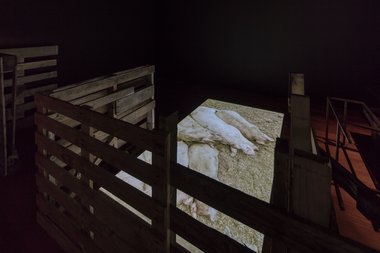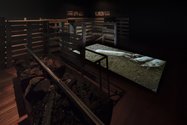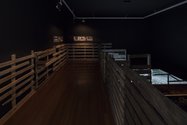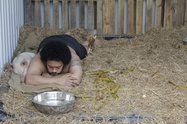John Hurrell – 28 January, 2017
I personally greatly enjoy eating pork and ham, especially around Christmas time, but I also enjoy observing the intelligence and personalities of pigs when I visit farms or agricultural shows, so I can't escape a certain amount of conflictual soul searching, which this exhibition pushes my nose in. As the Te Tuhi blurb accurately says, “the pigs in ‘Uhila's work…(while) significant as sacred animals of Tongan lore (are)…also surrogates for the human body.”
Pakuranga
Kalisolaite ‘Uhila
Pigs in the Yard II
12 November - 18 March 3017
Kalisolaite ‘Uhila is well known for his performances that spotlight the plight of the homeless; the difficulties of having no money and living on the street. (Being a finalist in the second most recent Walters Prize upped his national profile.) This suite of documentary projects differs in that it examines his interaction (as human representative) with domestic animals, in particular that commonly denigrated mammals, the pig.
In Tonga pigs are allowed to roam around comparatively free (not in batteries), being regarded as sacred, but they are slaughtered and eaten on certain ceremonial occasions. In this show we are presented with a pen-like structure that we can walk through, and see two sets of three spot-lit photographs recording two earlier performances. One set (a one day performance in Mangere Arts Centre, 2011) shows the artist and his audience restricted to being behind fences while the animals are free in a courtyard. A second (documentation of a one week performance in Performance Arcade, Aotea Square, 2011) has the artist lying in a straw-filled pen alongside a very relaxed piglet.
A third component features a large video monitor flat on the floor, showing the daily lives of a sow, boar and about eight piglets, filmed from above as they snuffle around for food, roll in the straw and dirt, and jostle for advantageous positions. Next to the screen are the fenced-off remains of a spit, and charcoal, from when one of the animals was cooked and eaten by the artist, family and guests during the exhibition’s opening function.
This show is clearly not intended to provoke, yet it surely will upset some vegetarians and vegans, even though there are no disturbing images and no traces of grease or smell. It is a sensitive (unfrivolous) presentation, one not deviating from a certain matter-of-factness. It makes its point without being gruesome. ‘Uhila has a great empathy for other people and other sentient beings or creatures - that seems to be a characteristic of his practice - but he is not sentimental.
I personally greatly enjoy eating pork and ham, especially around Christmas time, but I also enjoy observing the intelligence and personalities of pigs when I visit farms or agricultural shows, so I can’t escape a certain amount of conflictual soul searching, which this exhibition pushes my nose in. As the Te Tuhi blurb accurately says, “the pigs in ‘Uhila’s work…(while) significant as sacred animals of Tongan lore (are)…also surrogates for the human body.”
Attached to this (what I see as) paradoxical - even contradictory - empathy is also an implied secondary theme (also explained), that of space, bodily control and social structure. This metaphorical spatial and therefore sociological aspect is salient - and of great interest - but it is overshadowed (I think) by the dietary ethical issues. They dominate the emotional tone of the exhibition.
John Hurrell




 Two Rooms presents a program of residencies and projects
Two Rooms presents a program of residencies and projects Advertising in this column
Advertising in this column



This Discussion has 0 comments.
Comment
Participate
Register to Participate.
Sign in
Sign in to an existing account.